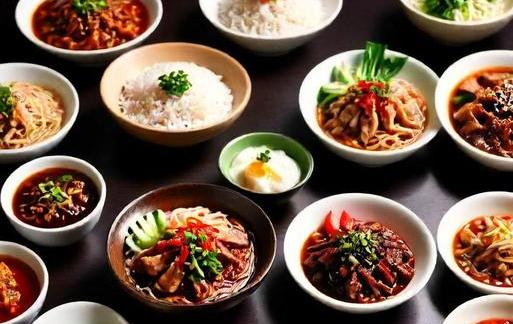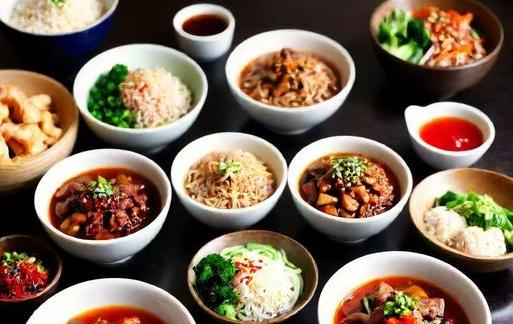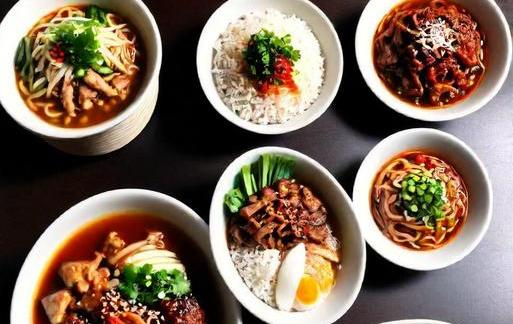- You are here:
- Home »
- Food
- » [REVEALED] Asian Foods That Start With M
[REVEALED] Asian Foods That Start With M
Note: This page contains affiliate links.
As an Amazon Associate, I earn from qualifying purchases when you click on the link, but you are not charged extra.
Asian cuisine is a tapestry of flavors, textures, and aromas that captivate the senses. From savory to sweet, spicy to mild, Asian foods offer a diverse range of culinary experiences. In this exploration, we delve into the realm of Asian gastronomy to uncover an array of delectable dishes that all share a common starting point: the letter "M." Join us on a flavorful journey through the intricacies of these dishes, each representing a unique facet of Asian culinary heritage.
Contents
List Of Asian Foods That Start With M

1. Miso Soup
Origin: Japan
Miso soup, a staple in Japanese cuisine, is a savory broth made from fermented soybean paste, called miso. This comforting soup often includes ingredients like seaweed, tofu, and green onions, creating a harmonious blend of umami flavors. Miso soup is not only delicious but also rich in probiotics, making it a nourishing choice.
2. Mapo Tofu
Origin: China
Hailing from the Sichuan province of China, Mapo Tofu is a fiery and flavorful dish featuring tofu cubes cooked in a spicy chili and bean-based sauce. Sichuan peppercorns add a unique numbing sensation, creating a perfect balance of heat and complexity. This dish exemplifies the bold and robust nature of Sichuan cuisine.
3. Massaman Curry
Origin: Thailand
Massaman Curry, a Thai culinary gem, is a rich and aromatic curry that perfectly blends sweet, savory, and spicy flavors. Typically made with coconut milk, potatoes, peanuts, and a variety of spices, Massaman Curry is a celebration of the diverse ingredients found in Thai cuisine. This curry is a delightful fusion of Thai and Indian culinary traditions.
4. Murtabak
Origin: Malaysia
Murtabak is a popular street food in Malaysia, characterized by a stuffed and pan-fried flatbread. The filling often includes minced meat, eggs, onions, and a blend of aromatic spices. Served with a side of curry sauce, Murtabak is a savory and satisfying dish that showcases the multicultural influences present in Malaysian cuisine.
5. Mochi
Origin: Japan
Mochi, a traditional Japanese treat, is a chewy rice cake made from glutinous rice. This versatile ingredient is transformed into various shapes and sizes, often filled with sweetened red bean paste or ice cream. Mochi reflects the meticulous craftsmanship in Japanese culinary traditions and is enjoyed in both traditional and modern forms.
6. Manchurian
Origin: India/China
Manchurian is a popular Indo-Chinese dish that has become a favorite in both countries. Consisting of deep-fried vegetable or meat balls coated in a tangy and savory sauce, Manchurian embodies the perfect blend of Indian and Chinese culinary influences. Its addictive flavors and textures make it a crowd-pleaser across diverse palates.
7. Miang Kham
Origin: Thailand
Miang Kham, a traditional Thai snack, offers a burst of flavors and textures in a single bite. Betel leaves are used as wraps for a combination of ingredients such as lime, ginger, peanuts, and dried shrimp, all topped with a sweet and savory sauce. This dish encapsulates the essence of Thai cuisine, showcasing the harmonious balance of sweet, salty, sour, and spicy flavors.
8. Mee Goreng
Origin: Indonesia
Mee Goreng, a popular Indonesian fried noodle dish, is a flavorful combination of noodles, vegetables, and proteins, stir-fried to perfection. The dish is elevated with a robust sauce made from a blend of soy sauce, chili, and various aromatic spices. Mee Goreng is a testament to the diverse and vibrant street food culture in Indonesia.
9. Mongolian Hot Pot
Origin: Mongolia/China
Mongolian Hot Pot, though named after Mongolia, has deep roots in Chinese cuisine. This communal dining experience involves cooking thinly sliced meats, vegetables, and noodles in a simmering broth at the dining table. The dipping sauces and condiments add layers of flavor to this interactive and social culinary adventure.
10. Malabar Parotta
Origin: India
Malabar Parotta, also known as Kerala Parotta, is a flaky, layered flatbread from the Malabar region of India. Made with refined wheat flour and a touch of ghee, the parotta is skillfully folded and cooked to perfection. Served with spicy curries or savory gravies, Malabar Parotta is a delightful culinary creation that represents the rich culinary heritage of Kerala.
The world of Asian cuisine is a treasure trove of culinary delights, and the letter "M" introduces us to a captivating array of dishes. From the comforting warmth of Miso Soup to the explosive flavors of Manchurian, each dish tells a story of cultural heritage, culinary craftsmanship, and a deep appreciation for diverse ingredients. The journey through Asian foods that start with "M" is not just a gastronomic adventure but also a celebration of the rich tapestry that makes Asian cuisine a global culinary phenomenon. As we savor the flavors and textures of these dishes, we come to appreciate the artistry and diversity that define the vibrant culinary landscape of Asia.
Significance

Asian cuisine is renowned for its rich diversity, vibrant flavors, and unique culinary traditions. In this exploration of Asian foods, we will focus on a fascinating subset – dishes that start with the letter “M”. From mouth-watering mains to delectable desserts, the Asian continent boasts a plethora of culinary delights that showcase the region’s cultural richness and culinary expertise.
The significance of exploring Asian foods that start with ‘M’ lies in unraveling the culinary tapestry of a continent known for its gastronomic treasures. By delving into specific categories and discovering unique dishes, one gains a deeper appreciation for the variety of flavors, ingredients, and cooking techniques that define Asian cuisine.
Category-Related

1. Main Courses
Mapo Tofu
Originating from China’s Sichuan province, Mapo Tofu is a fiery and flavorful dish that combines silken tofu with minced meat, usually pork or beef, and a spicy chili and bean-based sauce. Served with steamed rice, this dish exemplifies the bold and complex flavors of Sichuan cuisine.
Mee Goreng
Hailing from Indonesia, Mee Goreng is a stir-fried noodle dish that tantalizes the taste buds with a harmonious blend of sweet, savory, and spicy flavors. Typically featuring prawns, tofu, and a medley of vegetables, Mee Goreng showcases the diverse ingredients prevalent in Indonesian cooking.
Massaman Curry
A Thai culinary masterpiece, Massaman Curry is a rich and aromatic curry that seamlessly marries influences from Indian, Persian, and Malay cuisines. This dish often features tender chunks of meat, potatoes, and peanuts, all bathed in a sumptuous coconut milk-based curry sauce.
2. Snacks And Street Food
Momo
A beloved snack originating from Nepal and Tibet, momos are steamed or fried dumplings filled with a delectable mixture of meat or vegetables. Served with a tangy dipping sauce, momos have gained international popularity, becoming a favorite street food item in various Asian countries.
Murtabak
A popular street food in Malaysia and Indonesia, Murtabak is a savory stuffed pancake filled with a mixture of minced meat, eggs, and onions. This delightful snack is often enjoyed with a side of curry sauce, adding an extra layer of flavor to each bite.
3. Desserts
Mochi
Hailing from Japan, Mochi is a chewy and glutinous rice cake that comes in various flavors and fillings. Traditionally eaten during the Japanese New Year, Mochi has evolved to include an array of innovative fillings such as red bean paste, ice cream, and fruit.
Mango Sticky Rice
A popular Thai dessert, Mango Sticky Rice combines sweet sticky rice with ripe mango slices and a drizzle of coconut milk. The interplay of textures and flavors in this dessert exemplifies the balance and creativity inherent in Thai sweets.
Common Themes
Despite the diverse origins of these Asian dishes, certain common themes emerge that reflect the shared culinary heritage of the continent.
1. Spice And Heat
Many Asian dishes, regardless of their country of origin, embrace bold and spicy flavors. Whether it’s the fiery Mapo Tofu from China or the aromatic Massaman Curry from Thailand, the use of various spices and chili peppers is a common thread that ties together diverse Asian cuisines.
2. Rice As A Staple
Rice, in its various forms, is a staple ingredient in Asian cuisine. From the steamed rice accompanying Mapo Tofu to the sticky rice in Mango Sticky Rice, this grain serves as a foundational element, providing sustenance and texture to a wide array of dishes.
3. Culinary Adaptability
Asian cuisine exhibits a remarkable adaptability, incorporating and fusing diverse ingredients and cooking techniques. The Mee Goreng from Indonesia, influenced by the country’s history of trade and cultural exchange, reflects this adaptability by blending Chinese, Indian, and European culinary elements into a uniquely Indonesian dish.
Interesting Facts
Delving into the world of Asian foods that start with ‘M’ unveils a treasure trove of interesting facts that highlight the cultural and historical significance of these culinary delights.
1. The Evolution Of Mochi
Mochi, originally a Japanese creation, has evolved over the years, transcending cultural boundaries. Today, it is not only a beloved Japanese treat but also enjoys popularity in various forms across Asia and even in Western countries, where it has become a trendy dessert.
2. Mapo Tofu’s Fiery Legacy
Mapo Tofu gets its name from the pockmarked (ma) old woman (po) who supposedly invented the dish in Chengdu, China. The fiery flavors and numbing sensation associated with Sichuan cuisine, often attributed to the generous use of Sichuan peppercorns, are evident in this iconic dish.
3. The Cultural Symbolism Of Mango Sticky Rice
In Thailand, Mango Sticky Rice is not only a delicious dessert but also holds cultural significance. It is often associated with the Thai New Year, known as Songkran, and is enjoyed during festive celebrations as a symbol of prosperity and good fortune.
Conclusion
Exploring Asian foods that start with ‘M’ provides a glimpse into the rich and diverse culinary landscape of the continent. From savory main courses like Mapo Tofu and Mee Goreng to sweet delights like Mochi and Mango Sticky Rice, each dish tells a story of cultural heritage, culinary innovation, and the shared love for bold and harmonious flavors.
As we savor these Asian ‘M’ delights, we not only indulge our taste buds but also embark on a culinary journey that celebrates the creativity, adaptability, and cultural richness that define Asian cuisine. So, the next time you encounter an Asian dish starting with ‘M’ on a menu, know that it is more than just a meal – it’s a culinary masterpiece that reflects the vibrant tapestry of Asian gastronomy.


